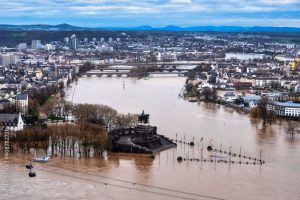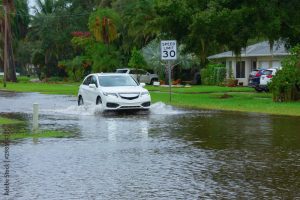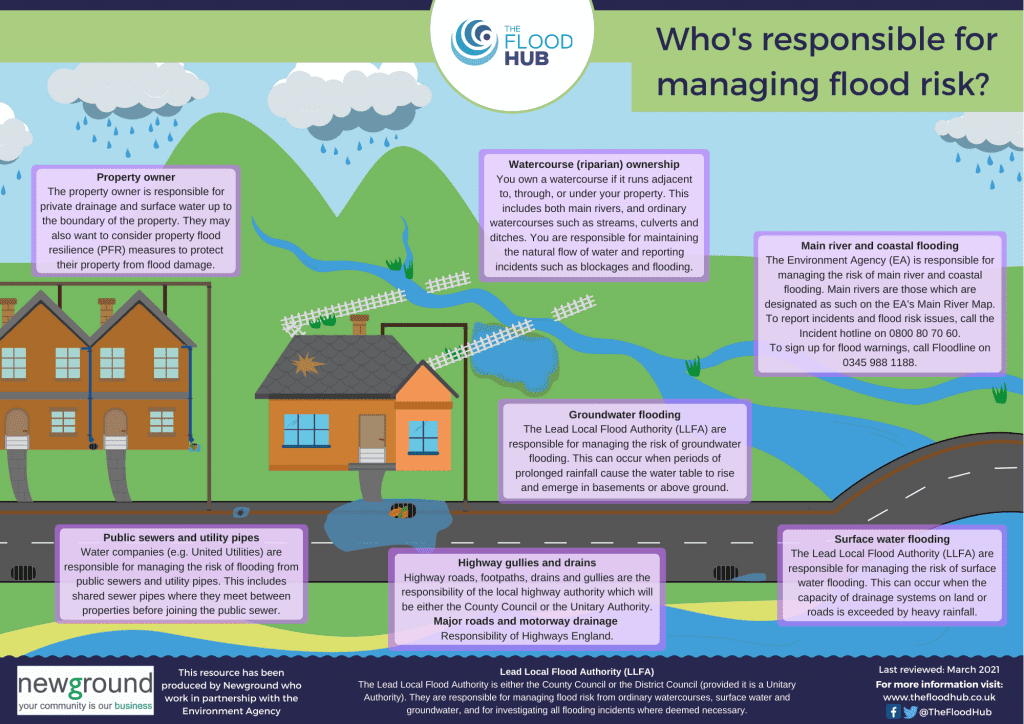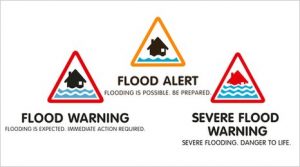What causes surface flooding?
Surface flooding happens when rain is so substantial that the ground cannot cope and drain water away quickly enough. In the instance of flooding, roads can become like rivers, buildings can become flooded and cars can be carried away.
Severe flooding is caused by atmospheric conditions that lead to heavy rain or the rapid melting of snow and ice. Anywhere can flood, but areas located near rivers are more at risk.
Monday’s IPCC report on climate change signalled ‘a code red for humanity‘. The report stated that “heavy rains fueled by warmer air will increase the number of deadly floods across the planet’.

Gravel Driveway Grid
Does climate change cause flooding?
The UN Scientific Report stated:
“Human activity is changing the climate in unprecedented and sometimes irreversible ways.”
The study warns of increasingly extreme heatwaves, droughts and flooding, and a key temperature limit being broken in just over a decade.
Researchers have said “flooding is the environmental disaster that impacts people more than any other.”
By 2030, millions will experience increased flooding due to climate and demographic change.
The IPCC report stated: “The recent flooding disasters in Germany, China and Afganistan share a characteristic that is on the rise: flash flooding. It isn’t clear whether such individual events can be blamed on climate change, even though generally higher temperatures can cause more moisture to gather in the atmosphere. And other factors like the age of infrastructure and river management can contribute to death tolls from flooding.
“But as intense rains have become more common across the globe, these types of rapidly moving and often deadly flood events have increased in number of the past decade,” according to Robert Brakenridge of the Dartmouth Flood Observatory at the University of Colorado.
Urbanisation and flooding
Flooding is increasingly effecting areas not pinpointed as “at risk areas”.
When Hurricane Harvey hit Texas in 2017, around 80,000 homes were flooded that were not on government risk maps.
Between 2000 and 2018 around 290 million people were directly affected by flooding. These areas have seen population growth of up to 86 million over the last 20 years.
This represents an increase of 20-24% in the proportion of the world’s population that is exposed to flood risk – ten times higher than previous estimates.
The countries with increased flood exposure risk were mainly located in Asia and sub-Saharan Africa.
Around 90% of the flood events observed by scientists were in South and Southeast Asia.
Dr Beth Tellman from the University of Arizona and Chief Science Officer at Cloud to Street, a global flood-tracking platform, said:
“We were able to capture a lot of floods in Southeast Asia more than other places, because they’re so slow-moving and so the clouds move and we’re able to get a really clear image of the flood.
“But there was also just a lot of flooding, really high impactful flooding in southern Asia and Southeast Asia. There’s also a large human population that settled near rivers for really important reasons [such as] agriculture. This, unfortunately, exposes people to a lot of flooding events.”
The global population grew by over 18% between 2000 and 2015, while in areas of observed flooding, the population increased by 34%.
While climate change has significant consequences on climate change, economics – and urbanisation – plays an important role.
“Places that have flooded tend to be really cheap land for informal development, so in Guwahati, India and Dhaka in Bangladesh, we see people moving in, and so flooded areas then become settled.
“It may not be people’s choice to live in those areas because they might not have a lot of agency. If there were really good public housing programmes or other options, I think people probably wouldn’t choose to settle in a hazardous area.”
How many people are at risk of excess flooding?
It is estimated that by 2030 there will be an extra 25 countries experiencing increased flooding (in addition to the 32 being impacted at present).
Dr Tellman said: “We estimate that an additional new 179.2 million people will be exposed to floods by 2030 in 100-year sozes and most of that is due to demographic change.
“Around 50 million extra people will be exposed to inundation, we think, due directly to climate change explicitly.”
Recodrain
Surface flooding in the UK and Europe
Flooding has taken a toll all over Europe. In Germany 93 people died after extreme flooding devasted the country.
The western state of Rhineland-Palatine and North Rhine-Westphalia are worst hit by extreme weather conditions with “buildings and cars washed away.”
The Netherlands, Luxembourg and Switzerland have also been badly affected.
BBC Correspondent Jenny Hill reported: “All along the River Ahr there are flooded homes, broken bridges, the twisted remains of campsites and caravan parks.”
In the district of Ahrweiler “up to 1,300 people are unaccounted for” and villages were “almost entirely destroyed.”
London also experienced flash flooding this summer, when “nearly three inches of rain hit the capital in 90 minutes.” This resulted in flooded streets, basement flats, Tube stations and high streets.
According to meteorologists said the floods in Germany were caused by “a low-pressure vortex circling over Europe” that is “hemmed in by other weather fronts.”
The “near-stationary” low-pressure weather system, dubbed “Bernd” has concentrated freak rainfall over European nations.
European Commission President Ursula von der Leyen said these floods “really shows the urgency to act” on climate change, as extreme weather events are “hitting Europe more frequently as climate change warms the continent.”
2020 was Europe’s joint hottest since records began. Eight of the ten hottest ever years occurred in the past decade.
“Warmer air holds more water which, in turn, can lead to extreme downpours.”
Euronews states: “Changes in the geography of the land can also contribute to flooding, with important vegetation and other land barriers broken down as part of changing temperatures and freak weather patterns. “This means that many of the natural preventative measures against flooding are no longer there.”
The IPCC predicts that flooding will be concentrated in northern and central Europe, including the UK and Ireland, while “the south roasts”.
Sea levels will also rise causing “extreme and permanent flooding along Europe’s coasts”, especially in low-lying cities in Germany, Belgium and the Netherlands.
Permeable Paving Discussion on BBC Radio 4
Listen to a discussion on Permeable Paving featuring the benefits of X-Grid to reduce the risk of flooding.
Who is responsible for managing UK flood risk?
- A map showing the potential extent of flooding to properties from rivers, surface water or reservoirs across the UK, including he long term flood risk for a property.
- A flood map used in development planning to find out the probability of flooding for a location, by flood zone.
- A 5-day flood risk forecast highlighting the risk level of areas from very low to high.
Different authorities and individuals are responsible for different types of flooding.
The householders are responsible for managing flood risk from:
- Internal flooding
- Any damage caused by storm events
- All prevent drainage inside and up to the boundary of the property
Watercourse owners are responsible for maintaining watercourses that run through, beneath, or adjacent to their land, including culverts, ditches, brooks, dykes and streams.
River flooding is the responsibility of The Environment Agency. River flooding occurs as a result of intense or sustained rainfall across a catchment that exceeds the capacity of a rivers’ channel. The Environment Agency has overview of all sources of flooding and coastal erosion.
Surface water flooding is when the volume of rainfall exceeds the capacity of drains and surface water sewers and is unable to drain away through drainage systems or soak into the land. The intensity of this flooring can be increased by blocked road gullies, drains and sewers and waterlogged land. It is made worse by hard surfaces. The Lead Local Flood Authority (LLFA) have responsibility for this type of flooding.
Groundwater flooding occurs when the water table rises up above the surface, usually during a prolonged wet period. Low lying areas, cellars and basements are more likely to experience groundwater flooding.
Sewer flooding can occur as a result of blockages caused by misuse of the sewerage system. It is the responsibility of water and sewerage companies.
Coastal flooding occurs due to high storm winds and low pressure. It is overseen by the Environment Agency.
Road flooding is most commonly caused by blocked gullies and drains.
Flash flooding occurs as the land is unable to cope with heavy rainfall. It is most common on land which has experienced a prolonged dry spell and urban areas with large amounts of hard surfaces. The source of the flash flood will determine who is responsible.
Reservoir flooding can cause major damage. Most large reservoirs are operated by water companies or the Environment Agency, and are regularly monitored and inspected to ensure they are safe.
Canal flooding is overseen by The Canal and River Trust.
Flood alerts provide pre-warned risks towards properties, via the Environment Agency. These include:
Flood Alert: Flooding is possible. Stay vigilant and make early preparations for a potential flood.
Flood Warning: Flooding is expected. Immediate action is needed to protect yourself and your property.
Severe Flood Warning: Severe flooding is expected. There is a significant risk to life and property. You should prepare to evacuate and cooperate with emergency services.
Related Blog Post
Read 'Plastic Waste - A Global Problem on Your Doorstep' here.
What can be done to prevent flooding?
If flooding is expected:
- Put property flood resilience measures such as flood barriers in place
- If you have a flood kit or flood plan get them out and ready to use
- Move items upstairs or to safety if you can
- Move your car to safety if you can
- Stay up to date with local weather and travel on the TV, radio or social media
If you need to evacuate:
- Turn off the gas, electricity and water supplies
- Follow advice from the emergency services
- Move family and pets to safety
- Call 999 if in danger
Flooding can also be prevented before it occurs using permeable solutions.
Permeable Paving
Permeable paving are solutions to allow for infiltration of stormwater runoff. It can include pervious concrete, porous asphalt, paving stones and interlocking pavers. It is used in a variety of applications such as roads, car parks and pedestrian walkways.
Block paving can be used to create a contemporary or traditional patio. Decorative patio stones mean gardens can be enjoyed all year round. Permeable block paving prevents puddles as the porous materials allow water to soak into driveway blocks.
Porous tarmac is a fast-draining porous asphalt solution. It is designed for the long term while it possesses drainage characteristics.
Finally, the permeable paving grid is lightweight, strong and durable. It is highly effective at reducing surface water, while maintaining an attractive surface. X-Grid is an example of a permeable paving grid.
X-Grid: X-Grid is a versatile, SUDS compliant ground reinforcement grid which is suitable for a number of applications including driveways, patios and footpaths. The permeable nature of the grid allows water to pass through the structure into the sub-base below and helps to reduce surface water run-off. This helps to mitigate the effects of severe or sudden rainfall by locking groundwater into the sub-base for it to gradually soak away, diverting water from the sewer system.
Channel Drain
Another way of reducing surface water is by installing an effective drainage system. Drainage channels are commonly found around driveways, patios, garages and conservatories.
RecoDrain Channel Drain: Plastic channel drainage system creates an effective drainage route that is easy to install and helps to reduce surface water. It is designed to redirect water away to mains or an off-grid underground drainage system. It can withstand 1.5 tonnes and can be connected to other RecoDrain to create a drainage channel of any size.
Soakaway Crates
Soakaway crates are constructed using modular water storage cells. The crates loosely resemble old-style plastic milk crates and collect water from sandy or loamy soil from 40-70cm below the surface.
RecoCrate Soakaway Crates: RecoCrate is a range of recycled plastic crates for soakaways, attenuation and storm water management. It is used to create permeable infiltration schemes, underground water storage and attenuation systems. They are versatile products that can be used under car parks, landscaped areas and heavy-duty projects within retail, commercial and industrial areas. It can be used to collect as much water as possible using a non-permeable membrane to prevent liquid from escaping or can be used with a permeable membrane to slowly release water into the ground.
Resin Bound Gravel
Resin Bound Gravel: This is also a permeable solution that prevents the build-up of surface water. Resin bound gravel is a SUDS compliant solution used in conjunction with a porous base allowing rainwater to drain away naturally.
A wide range of colours and combinations are available, it is non-slip and will not fade over time. Ideal for car parks, footpaths, bus lanes and road markings.
What can be done to reduce climate change?
Speak Up: The biggest way to make a difference on global climate change is by influencing friends and family, and community leaders into making good environmental decisions.
Use renewable energy: Choose a utility company that generates power from green sources, such as wind or solar.
Weatherise: Heating and air conditioning use almost half of home energy use. Instead improve installation in the home to reduce these costs.
Search for energy-efficient appliances: Since 1987, rising efficiency standards have kept 2.3 billion tons of carbon dioxide out of the air. By searching for energy efficient refrigerators, washing machines etc this trend can continue.
Reduce water waste: To reduce carbon pollution, reduce water waste. It takes a lot of energy to pump, heat and treat water, so use water-efficient fixtures and avoid excess running water.
Don’t waste food: A lot of energy goes into growing, processing, packaging and shipping food – with a large percentage ending up at landfill. By reducing this waste, you can cut down on energy consumption. Livestock products are among the most resource-intensive so eating meat-free meals can make a difference.
Buy better bulbs: LED lightbulbs use 80% less energy than conventional incandescents and will save money.
Unplug devices: Plug points in the home are likely powering around 65 different devices, however many of these sit idle. Set monitors to power down after use.
Drive fuel-efficient vehicles: Gas-smart cars, such as electric vehicles, save fuel and money.
Choose trains over planes: Air transport is a major source of climate pollution. Walking and train travel is preferable, ensuring money is saved and pollution kept to a minimum.
Antonio Guterres said: “If we combine forces now, we can avert climate catastrophe. But, as today’s report makes clear, there is no time for delay and no room for excuses. I count on government leaders and all stakeholders to ensure COP26 (climate summit) is a success.”
Summary
Surface flooding is on the rise in the UK, Europe and around the world.
The increase in global temperatures caused by climate change is resulting in melting ice caps, sea levels rising and more extreme weather conditions.
The IPCC (UN body on climate change) has said that the latest report into climate change is a “code red for humanity”.
Flooding in the UK is everyone’s responsibility, from homeowners and individuals, to businesses and authorities. The Environment Agency issues several warnings – from flood alerts to severe flood warnings – to raise awareness of flood risk and encourage people to take action which can save lives and livelihoods.
Long term, it is everyone’s responsibility to reduce the risk of climate change. Steps can include reducing air travel to unplugging devices. Ultimately, Governments can act as an influencer of change, and are being lobbied to do so alongside the general public.
Resin Bound Gravel












